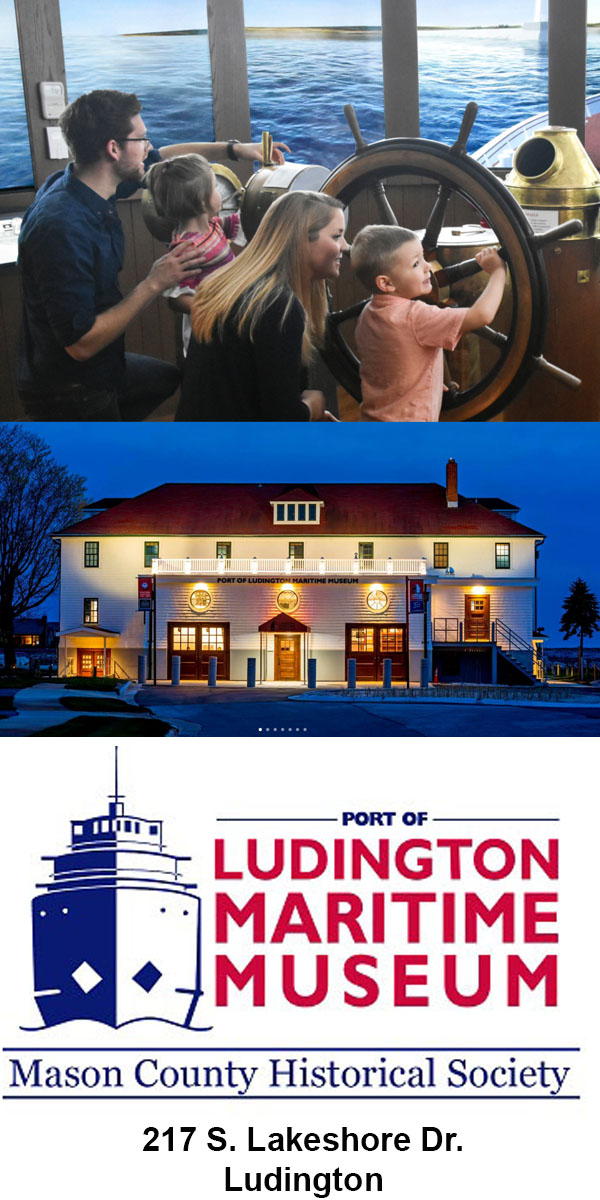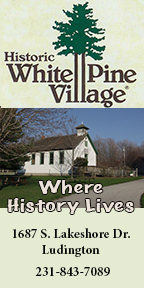
Amber District No. 4, Star. Year unknown.
History: The schools of Amber Township
By Rob Alway, Editor-in-Chief.
Editor’s Note: MC History Spotlight is a regular history column brought to you by Ludington Woods Assisted Living and Memory Care.
Prologue: Public education in Mason County today looks much different than it did in the 19th century and first half of the 20th century. In the mid- to late-1800s, transportation and roads in Mason County were much different than they are now. Schools were built in the center of populated areas, with the intention that children wouldn’t have to walk more than 2 miles to get there. Essentially, each rural school building was its own district with each having a three-person school board.
The first records of public schools in Mason County date back to when the county was organized in 1855. Some of the first schools were established in modern Pere Marquette, Custer, and Victory townships.
By the early 20th century, the county had 69 separate school districts with 74 buildings.
In the early 1900s transportation and roads improved while populations shifted and consolidation of the rural schools started taking place, a process that continued for almost 70 years.
These stories are not complete. I am always in the search for more details and more first (or second) hand accounts about the schools. The ultimate goal is to compile these school history stories into a book.
In these articles names of modern roads are used to describe where the school buildings were located. Many of these roads were merely trails back in the 1800s and early 1900s and few of them had names. Most roads in Mason County did not get named until the late 1940s. Also, the term “fractional” means that the district was split between at least two municipalities.
 Amber Township
Amber Township
The first non-natives began to settle the area now known as Amber Township about 1860. William Carter is credited as being the first settler in the township. His property was located on the land that is now the southern portion of Scottville’s Brookside Cemetery. His son, Charles, was the first non-native child born in the township.
There are contradicting stories of how the township received its name. One historical article states that C.W. Jones named the township after the town he came from in Indiana. However, there are no records of an Amber, Indiana.
Andrew and Frances (Holmes) Neal were the first couple to get married in the township, on Sept. 19, 1865. Their descendants continue to live on the family homestead in the area of Johnson Gordon roads.
The first Amber Township meeting was held April 6, 1868 in the Burnette school house (see below). Orenzo Rice was elected the first supervisor; other elected officials were Jesse Towns, clerk; James Flora, treasurer; and highway commissioners were Charles Hackert, James H. Conrad, and John D. Chandler. First justices of the peace were H.H. Woods, John L. Jensen, Aran Rice, and Jacob Hoover.
Those who signed the application in 1867 for Amber Township to be organized included: W.H. Coon, Daniel Prindle, L.D. Holly, Amos W. Wilson, Joseph Turner, John Winters, William W. Leach, Andrew Niel, Hiram Chipman, Joseph Hubbard, John Burnett, Robert Baker, C.W. Jones, J.I. Penfield, G.W. Williams, Charles W. Barclay, Richard Beattie, John R. Genson, William Congor, and J. Neidig.
The history of Amber, like many communities in Mason County, goes hand-in-hand with the lumber industry.
In a Ludington Daily News article, long-time rural correspondent Emma Barclay (bylined as Mrs. Frank Barclay) stated about Amber:
“In earliest days this was first a passageway from the village on the lake (Pere Marquette) to the timber woods in the east, and the road, following the Pere Marquette River was traveled mostly by river men and lumbermen, going and coming form the woods. The river was used for transportation, with a small tug making the trip up to what is now the Chinnery and John Conrad farms (near the corner of Conrad and Gordon roads), leaving supplies on the bank and probably helping drive the logs from the camps to the mills at Ludington.”
Mrs. Barclay continued that the first settlement was a place named Jordan, about 1/2 mile west of what is now Scottville. “This was platted but never built up. Later a station, or stopping place, was made about 1/2 mile west of the present Amber Station, then later moved to the present Amber station which for a time was quite busy with a bowl mill, store, railroad station, doctor and meeting hall — a real live place.”
The Flint & Pere Marquette railroad, from Saginaw to Ludington, was completed in Ludington on Dec. 1, 1874, ending at Pere Marquette Lake.
Amber Township School District No. 2, Amber Station School
Amber School District No. 2, also known as Amber Station School, was organized in 1867 (a year before the township was formally organized) by Jesse L. Towns, one of the earliest settlers of the township who lived on the north side of Johnson Road east of Stiles Road (modern day Alway farm). A Sept. 24, 1959 edition of Mason County Press recounted that Towns notified Township Supervisor Chauncy Rickert of the plans. Rickert then proceeded to travel around the township, “on foot and horseback to notify every member of the community.”
“Most of the settlers were Civil War veterans who settled here to make their homes,” Walter Gowan wrote in a newspaper article published in the 1950s. “Seeing the need to educate their children in the country they proceeded to organize school districts even before the township was organized.”
Shorty after that meeting, a log school house known as the Burnett School was built on the southwest corner of First Street and Amber Road on the Adam Pletcher farm (another account says the property was owned by the Davis family). Martha Evans was the first teacher.
Around 1920, my grandmother, Helen (Nicely) Alway, wrote an essay for her eighth grade class on the history of Amber Township.
“The interior of the school building was similar to that of any old fashioned school with its benches, dunce block and water pale. The next year Lily Garlock came here from New York state and taught for awhile. Mary Van Densen, a relative of the Foster family of Ludington and also David Conrad were among our pioneer teachers.”
A side note about my grandmother. Helen Nicely came to Amber Township from Green Valley, Illinois (an area near Peoria) in February 1907 when she was 6-weeks-old. She loved telling the story of how her father, James Nicely, who had worked on the railroad in Illinois, had preceded the family and settled on land on the northeast corner of what is now Quarterline Road and First Street. Helen’s mother, Ella Mae (Browner Quigley) Nicely, arrived on a winter’s evening at Amber Station (located about 1/4 mile to the east of the farm) in the dark, walked on the tracks and carried her new baby to the newly established family farm. Also walking were Helen’s siblings, Hazel, 14, Harold, 8, Vernice, 7, and Ralph, 3. Helen lived the rest of her life within 1 mile of that homestead, moving to Johnson Road after marrying my grandfather, Tom Alway, in 1934.

Emma Bishop and her 5-year-old daughter Ruth, a year after arriving in Scottville. Both Emma and Ruth taught at Amber Station School.
A school meeting was held on July 18, 1872 and those in attendance voted to raise $125 for the year’s expenses.
According to Helen Nicely’s essay, the Burnette School was destroyed by fire. In 1875, $150 was appropriated to build a new frame-construction building, which was located on the east side of present day Amber Road south of the railroad tracks. “Very different from (the Burnette School) is our neat little school house which we have today with its up-to-date seats, black board and its sanitary conveniences,” Helen Nicely wrote. “The Amber station school was constructed soon after the little log school burned.”
Historical accounts state the building had a fence built around it, with a stile for the children to come through. The fence kept stray animals out.
The first school board consisted of Charles W. Barclay, director; James Reed, moderator; and Charles B. Clay, treasurer. The first teacher was Lilly Coles who was paid $49 for teaching four months of school. The next teacher, Fred Fairbanks, was paid $87 for teaching five months.
Early teachers included Mary Rice, Flora Rice, Mary Morton (1882), Lily Sedman, Kager Kazer, Cyrus Tobey, Netta Weimer, Phillip Hall, Edgar Marsh, Jennie Legender, Minnie McClatchie, Allie Green, Lottie McKee, Frank Brighton, Harry Mustard, Norman Upper, Cora Knapp, Alice Smith, Wes Bailey, Charlie Gray, Lizzie Garlock, Annie Colburn, Ben Bidwell, Frank Keyes, Spencer Garrison, Mae Rinehardt (1903-1904) and Sherman Clay.
Three members of one family taught, through the years, at Amber Station School: Emma Loomis in 1885 (read Emma’s biography here on MCP), Ruth Bishop Falconer in 1896, and Ruth’s daughter, Emma Falconer McFarland from 1943 to 1947.
In 1955, Dell Reed, then 88-years-old, wrote about his experience and recollections of Amber Station School.
“My parents came here in 1871 when I was 4-years-old,” Reed wrote. “There were no railroads or state roads, just roads through the woods. The railroad wasn’t there until two years later.
“There was a little log school house a quarter mile south of the present railroad (corner of Amber Road and First Street). Mary Rice was my first teacher and Flora Rice was my second teacher. Then the district built the new school that is there now.”
Dell Reed’s father, James Reed, was one of the original school board members.
“It was pretty tough on the little folks to come to school in winter and sometimes we would stay home until the roads got broke out,” Reed wrote. “Some of my first schoolmates were Dora and Will Miller, Mina and Alice Neidigh, Jessie, Susie, and Minerva Hubbard, Lennon and Henry Knox, Luther Richard, Liga Holmes, Bob and Cora Purple.
Reed later became director of the school for 12 years until he sold his property and “moved to town.”
The school district was redistricted to Mason County Central in 1955. MCC used the building until 1960 and then closed it. Final consolidation took place in 1966.
The last school board members included Dr. Willard Dornbos, Richard Krupa, and Mrs. Fred Walker.
Amber Township School District No. 1, Jones School

Amber District No. 2, Jones School
Amber School District No. 1, Jones, was organized during a meeting on September 4, 1871. SNC Barron was elected director. During the meeting it was decided that property would be leased from the C.W. Jones farm on the southwest corner of what is now Johnson and Gordon roads. The size of the building would be 22-feet by 27-feet.
A motion that $50 be raised for incidental expenses failed twice.

Amber District No. 1, Jones, about 1904.
It was decided that school would be held for six months, three months in the winter and three months during the summer.
The school census list taken between 1871 and 1874. It included, among others, the children of some of the first settlers of the township, which included Dan Prindle, Jesse Towns, Joe Hubbard, Andrew Neil, and C.W. Jones (Jones came to the area from Indiana and named the township after his hometown).
The children included Lewis Towns, 15; Daniel Towns, 14; Jessie Towns, 10; Arthur Towns, 9; Robert Towns, 6; Adlavian Prindle, 17; Alvin Prindle, 10; Adda Prindle, 11; Walter Prindle, 7; Mile Gavit, 18; Richard Beattie, 18; James Beattie, 17; Susan Beattie, 16; Henry Beattie, 13; Robert Beattie, 11; Louise Beattie, 8; Charles Jones, 6; Maggie Neil, 5; Andy Neil, 6; Charles S. Barron, 17; Hopey Jensen, 15; Albert Jenson, 12; Frank Jenson, 10; Monro Williams, 13; Oliver Williams, 17; Charles Williams, 10; Sarah Williams, 8; Lusinda Eoff, 6; Arminta Prindal, 6; Augusta Shumaker, 10; Williams Shumaker, 11; Benty Shumaker, 7; Frank Murphy, 12; Martha J. Neil, 10; Jennie Neil, 7; James Neil, 6; Willie Darke, 9; Ebenezar Chipman, 15; Lucy Chipman, 18; Mereb Chipman, 12; Sebra Chipman, 16; Johney A. Chipman, 8; Peter Bean, 14; George Bean, 6; Jim Bean, 7.
The log house was used for 10 years. A new building was then built in 1881 on the southwest corner of modern Johnson and Gordon roads.

Amber District No. 2, Jones School, 1914
At one time the Jones district extended north as far as the M.J. Wilkes farm near Mud Lake (likely Vogel Lake, which is on the Amber and Victory townships line), south to the George Felt farm, west to the Jess Towns property (midway between Amber and Stiles roads on Johnson Road, modern Alway Farm), and east to Scottville. Before the formation of Amber District No. 6 in Scottville in 1877, children from town attended school at Jones School.
William Wood was hired as the first teacher to teach the winter term for $26. The summer term was taught by Minnie F. Thomas for $32 in 1873.
Other early teachers included Phillip Hall, Lena Gilding, Ruth Bishop (later Falconer), Winney Noyes, Lizzie Borton, and Oren Eaton.
Amber Township School District No. 3, Rickey

Amber District No. 3, Rickey, 1921. Front row, from left: Henry (Hank) Gebott, Joel Chinnery, Richard Keson, Hiram (Ned) Gebott, Woodrow Hacket, Willie Keson, Versial Hacket. Middle row, from left: Goldie Larr, Catherine Pittard, Elta Hacket, Wilda Larr, Ivabelle Larr, Frances Chinnery. Back row, from left: Teacher Nettie Murphy, Helen Arndt, Vivian Pittard, Helen Larr, Gertrude Swanson, Gust Keson, James Larr, Albert Keson, Margie Hacket, Edna Keson, and Joe Gebott.
According to a Sept. 24, 1959 article published in the Mason County Press newspaper, Rickey School was the first district to erect a framed school house, though Amber Station School and Jones School were organized prior to Rickey.
On May 29, 1870, Charles W. Jones, clerk of the board of school inspectors of Amber Township (namesake of Jones School) issued a notice to James C. Flora, chairman of the Amber Township board, to notify every legal voter of the district that on June 4, 1870 there would be a special meeting at the home of Henry B. Rickey for the special election of school officers and any other business that came before the meeting.

Amber District No. 3, Rickey, 1910. In background is the home of E. Sherman and Annie Brown. In front, from left: Vessie Brown, Mrytle Hammet, Esther Brown. Back, from left: Florence Laude, Ruth Conrad, Mary Brown, Glenn Hazzard, Grace Hacket, Emily Arndt, Hazel Quast. Kneeling, unknown.
The election of the school officers resulted in Charles Hackert being elected moderator for three years; James C. Flora, director for two years, and John Schreiner, assessor for one year. George Martin offered a grant of land (nine rods square) in the northeast corner of his farm for a school site. Following a vote, Mr. Martin was paid $12.50 for the land.
Originally voters had agreed to build a log house, but later chose to build a frame building, 24 feet by 30 feet. The school was built by Lewis Barton for $97. The first term of school began in January 1871 with James C. Flora as teacher.
The school was heated by a large box stove in the center of the room.
There were 26 pupils during the first term. They included James and Sarah Turner, Sabina, Ernest, and Delbert Chinnery, Crist Tetsloff, Jenny Monroe, Louisa, Katie, Minnie, John and Willie Schreiner, John William, Elizabeth and Rosa Hackert, Charles E. Bailey, George Huber, Neomi, Flora, Eva, and Velley Penny, Carrie Elmer, Clifton and Rosa Cole, and Charles Huber.
The winter term of school lasted three months and the summer term of two months began on May 29, 1871 with Rebecca Ash as teacher.
Other teachers were:
- 1872, Judson E. Wright, Julia Gage
- 1873-1874: Margaret McDonald.
- 1875: Eva Hull and George Reader
- 1877: James C. Flora
- 1878: Flora Rice
- 1879-1881: H.L. Day
- 1882: Ella Callahan
- 1898: Norman Upper
- 1899-1900: Sophia Meinkott
Other teachers before 1900 included Franklin Cope, Nellis Danaher, Claude MCClellan, Fanny Green, Laura Conrad, Grace Bishop, and David Warner.
Teachers who taught after 1900 included Jessie White, Bertha Hunt (1902), Maude Kistler, Christine Christensen, Lulu Gebott, C.E. Peler, Olive Hansen, Robert Masters, Rhea Welte, Tom and Cora Smith, Mamie Marquand, Muriel Cameron Rohrmoser, and Carolyn Garard.
In the fall of 1875, a whooping cough epidemic caused the winter term to be postponed until March 1876.
In 1900 a woodshed and two toilets were built at the rear of the school building. The building was also sided, and the exterior and interior were painted.
In September 1953, the school had 18 students with Ada Thompson as teacher.
In 1955, Rickey School was re-districted into Mason County Central Schools. The building was sold by the township in 1959 to Frank Staagard, a former pupil, and torn down in May 1960. The last school board members included Elmer E. Fredericks, Mrs. Harry Pappe, and Robert Conrad.
Amber Township District No. 4, Star (Moore)

Amber District No. 4, Star. Year unknown.
Sometime before 1880, a school was built on the northwest corner of the Charles Dahn farm, located on modern Conrad Road at Dennis Road. In 1880, that building was moved to the northwest corner of Conrad and Brye roads, according to Helen Bartlett in the Mason County 1980 history book published by the Mason County Historical Society.
In 1886, a new building was built, and was called the Moore School, Amber School District No. 4. It was named after Michael Moore, who lived across the street and most likely owned the property the school was built on.

Front row, from left: James Christensen, Leo Hansen, Agnes Bentz, Donald Nelson, Herald Echland. Second row, from left: Carol Mero, Wanda Sobanski, Elsie Nelson, Harold Bentz, John Mero, Marie Bentz, Charles Sobanski, Gustane Rickhoff, Marguerite Rickhoff. Back row, from left; Leo Sabanski, Herman Bentz, Marshall Eckland, Arlis Pedersen, Thelma Nelson, Madonna Bentz, last two unknown.
Lightning struck the building during the fall term of 1890, destroying it.
An account written by Carol (Mero) Ruba about the recollections of her aunt, Mary (Mero) Barclay talked about the fire. Mary attended the school with her siblings, Frank and Chester (who became Carol Mero Ruba’s father and also served as the school board’s director from 1917 to 1927).
“The Moore school was located on the site of the present Star school in Amber Township and was in session for the fall term in 1890 when fire started in the woods and brush near the school. The teacher, Miss Laura Conrad (who later married William Robinson) dismissed school and cautioned the children to go straight home.”
Mrs. Barclay, who was 8-years-old at the time, recalled being fascinated by the fire and going “down the road to see it and later watched the school building burn.”
The Moore home, across the street, was greatly endangered by the fire. Moore’s son, Tom, climbed the roof of the house and extinguished burning embers, saving the house, but severely burning himself, according to Mrs. Barclay’s recollections.
 Students were then sent to the Sinclair farm, 1/4 mile east of the Moore school site, where they attended school in a barn until the weather was too cold. They then held school in the Sinclair’s log cabin.
Students were then sent to the Sinclair farm, 1/4 mile east of the Moore school site, where they attended school in a barn until the weather was too cold. They then held school in the Sinclair’s log cabin.
“The district was divided at the time and the Star school was built on the location of the Moore school and the Eagle was built about two miles north of the Star school and fronting on the Ludington-Scottville road (southeast corner of US 10/31 and Brye Road),” Carol (Mero) Ruba wrote.
The new Star building was built in 1891.
In addition to her aunt’s memories, Mrs. Ruba also recounted her own memories of the school, which she attended from September 1918 to May 1926.
“One of the trials pupils and teachers had to endure was the use of pen and ink,” Mrs. Ruba wrote. “Each double desk was equipped with a small glass cup fitted into a round hole in the top corner of the desk. These were filled from a quart bottle of blue ink which resulted in a certain amount of spillage and ink stains on the desk tops. The lower grades through third did not use ink but from fourth grade on, we were initiated into the wonderful world of ink blots, ink spatters, wooden pen holders with steel pen points, smooth tablets, and blotters.
“Besides our textbooks, each child in grades kindergarten through third usually started school with a new six (crayon) box, which contained red, orange, blue, black, yellow and purple. From fourth grade through eighth we had paint boxes with eight colors, also a rough tablet for arithmetic and a smooth tablet in the upper grades along with pen and pen holders. We all had one or two lead pencils with too short an eraser.”
Mrs. Ruba recalled her first two years of school, beginning in September 1918, were taught by Ruth Fraidenburgh, who was on her first teaching assignment.
“These were the closing days of World War I and I remember the patriotic atmosphere at school and at home. We started the school day with the Pledge of Allegiance to the Flag. We often sang “America (the Beautiful)” and the “Star Spangled Banner.” We also gave current current events, especially ones about the progress of the war.
“I remember the Armistice that November. We were given time off from school and my parents took my brother and I to see the celebration in Ludington. The part I remember most vividly was the hanging of a straw effigy of the Kaiser. I was horror struck and could not hlep feeling sorry for the poor man. My parents explained that his army had killed many innocent women and children, especially Belgians. I hadn’t witnessed that but I had seen his horrible hanging body.”
Mrs. Ruba recalled some of her classmates her first year of school. They included Geraldine Buckles and Kenneth Marquand in the eighth grade; Edward, Leo, Charles, Wanda, and Frances Sobanski (children of William Bentz); Herman, Marie, Agnes, Clifford Bentz; Gertrude, Harold, and Edith Bentz (children of Fred Bentz); Madonna and Roland Bentz (children of Robert Bentz); Thelma, Donald, and Elsie Nelson; Gustave and Marguerite Rickhoff; Marshall and Gerald Eckland; Leo Hansen; James Christensen; Alice and Peter Chevis; Arlys and Ray Pedersen.
“Another highlight of the country school days was the visit of our commissioner of Mason County schools, George D. Griswold. He was a tall, stately man with attractive white hair and a friendly manner. We enjoyed his visits.”
“Things were very different for pupils then. We had lamplight at home, ‘a path instead of a bathroom’, no radio, television, very few books or other entertainment. Most families were too busy making a living to be very social. School was a very important factor in our lives. It was our path to tomorrow and might even let us aim for the stars. I for one did not foresee the cracking of the atom or the voyage to the moon.”
Some of the Star/Moore teachers from 1871 to 1891 included:
David Conrad, 1871; Mrs. Orin Rice, Miss Clark, Miss Bell, William Paul, J.E. Wright, Miss Smith, Paul Honkle, Mary Morton, Edwin Chambers, Flora Rice, Cassie Colburn, Nelly Patterson, Alice Day, W.R. Gonder, Ida Patterson, Katie Evans, Maria Maria McGrath, Emmaretta Caswell, Bertha Colburn, P.H. Hall, William Meisenheimer, Emma Albertson, Laura Robinson, Laura Conrad, Marie Crampton.
In 1956, the Star district was annexed into Ludington Area School District and closed in 1957. It consolidated completely with LASD in 1966.
Amber Township District No. 5, North Amber

Amber District No. 5, North Amber, 1912. Ann Fay, teacher, standing in back, left.
As the population of Amber Township spread out and increased, there was more need for more schools. District No. 5, North Amber, was established and a school building was built in 1885 on the east side of Stiles Road about 1/4 mile south of Hansen Road. The original building was destroyed by lightning in 1916.
In the Jan. 24, 1974 edition of the Mason County Press newspaper, Dawn Dornbos recalled the fire.
“It was a pleasant day in the spring of 1916, March 23, to be exact,” she wrote. “Young Mr. Robert J. Squires, teacher at the North Amber School, had a scheme to get the pupils to drink milk and was working well.
“He told them often, ‘This is the land of milk and honey. You should drink milk. If you’ll bring milk to school to drink with your lunch, I will too.’

North Amber School, built in 1885, prior to 1916 fire that destroyed the building. Photo from the collection of Nancy Miszewski.
“And so they did. This particular day Haskell Grinnell, a very bashful boy, was drinking his milk at an old desk in the school yard so the other kids wouldn’t’ see him drinking it. Suddenly he noticed flames and smoke coming from around the chimney. He burst breathlessly into the school and shouted, ‘Fire, the roof is on fire.’
“There were no fire drills in the school those days but the kids as well as the teacher went into action. The girls immediately began ringing the school bell to call the neighbors.
“The boys formed a bucket brigade, pumping madly on the old pump handle in the yard. Coal shuttles, pails, even lunch pails, were put into service in a bucket brigade.
“Mr. Squires put a long ladder against the roof and climbed the steep angle up to the chimney repeatedly to throw water on the fire.
“Meanwhile other boys ran into the school to salvage books, papers, records, and everything they could lay their hands on.”
Ultimately the fire destroyed the building. School was held at the Jastremski home for the remaining six weeks of the school year. Mr. Squires was given a raise for his service in helping to save the school. He returned the following term and then moved to Fern School. However, he shortly afterwards joined the U.S. Army to fight in World War I. He later married Charity Shoup of Tallman and they moved to Flint where he worked for the U.S. Postal Service.
A new brick building, which still exists, was opened in 1917.
In September 1953, North Amber had 18 pupils, taught by Mervyle Miller. The term included kindergartners Douglas Larsen and Gary Knudsen. Other students included: Richard and Raymond Peterson, first grade; Craig Larsen and Nancy Skowronski, second grade; Dennis Peterson and Joan Skowronski, third grade; Delcina Matevich, Beth Alway, Dwight Steve, David Knuden, and Karen Barnett, fourth grade; Ronald Skowronski and Christine Peterson, fifth grade; Dick Alway, Richard Knudsen, and Clifford Larsen, sixth grade. Board members included Homer Molyneux, moderator; Mrs. Stanley Matevich, director; Edward Larsen, treasurer.
In March 1954, residents of the district met to discuss eliminating the seventh and eighth grades.
In 1955, North Amber district joined Mason County Central School District. The building was used for a few years to house elementary students for the Central district. An August 31, 1956 Ludington Daily News article stated that North Amber School was housing fifth grade students from the districts of Pelton, Freeman, Rickey, Amber Station, Wilson, Menninger, and North Amber and sixth grade students from the districts of Amber Station, North Amber, Menninger, Rickey, and East Riverton.
The building was closed in 1960. In 1966 the district formally consolidated with MCC.
Amber Township District No. 6, Fractional, Scottville

Amber District No. 6, fractional, Scottville
Amber Township District No. 6, Fractional, was located in Scottville. Its origins begin in 1877 and in 1888 a two story brick building, holding grades kindergarten through 12, was built on Main Street at the intersection of James Street (the building still exists). The school district eventually became the Mason County Central School District. .
Amber Township District No. 7, Fractional, Lincoln Valley

Amber No. 7, fractional, Lincoln Valley. Submitted to Mason County Historical Society by Henry Marek.
Lincoln Valley School began in 1891. It was located on the north side of Hansen Road near the Pere Marquette Township line (near Meyers Road). The district included the northwest portion of Amber Township and the northeast corner of Pere Marquette Township.
The school closed in 1947 when the district annexed with the Ludington Area School District. The building was sold in 1950 and was eventually torn down. In 1966 the district consolidated with LASD.

Amber District No. 7, fractional, Lincoln Valley. Front, from left: Henry Marek, Josephine Marek, Bill Nickeson, Ernestine Listander, Marshall Peterson, Frank Anderson, Arlene Anderson, John Vigards, Loretta Rasmussen, Catherine Wicbicki, Ribert Knudsen, Leslie Rasmussen. Second row, from left: George Larson, Guy Rasmussen, helen Vizgaudis, Ivan Babcock, Howard Nickelson, Robert Weinert, Ralph Weinert, Mary Vizgaudis, Sophie Marek, Vera Babcock, Edith Knudsen, Ernest Rasmussen. Back, from left: Teacher Frances (Kirk) Listing, Ann Vizgaudis, Ruth Babcock, Harry Nickelson, Eigel Knudsen, Rose Marek, Stella Novick, Leo Weinert, Norman Bachman.

Amber District No. 7, fractional, Lincoln Valley, 1939. Teacher Aaron Miller is standing in back right. Front, from left: Patricia Petersen, James Winegar, Virginia Jansen, Vernita Fox, Jack Winegar, Gail Winegar. Second row, from left: Willa Jean Fox, Lillian Garland, Kathryn Jensen, Viola Jensen, Joyce Winegar, Mildred Jensen. In back, from left: Walter Garland, Archie Paul, Bob Smith, Leo Garland, Dorothy Wizbicki, Anna Marek, Evelyn Jensen.
Amber Township District No. 8, Eagle

Amber District No. 8, Eagle, 1926. Teacher Clara Dittmer is standing in the back. In front, from left: Dorothy Lund, Evelyn Lund, Irene Lund, Louis Lund, Stanley Motyka, Paul Johnson, George Petersen, Walter Motyka, John Vizgaudis, Richard Berg, Lee Petersen. Second row, from left: Henry Skow, Oscar Rhode, Anne Motyka, Mildred Petersen, Chatherine Petersen, Mary Vizgaudis, Bernice Petersen, Rarth Andersen, John Motyka, Manley Petersen. Third row, from left: Kermit Johnson, Arthur Kow, Guinhilde Andersen, Elna Petersen, Florence Lund, Ruth Johnson, Irene Pehrson, Gladys Berg, Sophia Motyka, Agnes Lund, Ida Rhode, Lester Pehrson.
The Eagle district was formed after the Moore School building was destroyed by fire in 1890 (see previous article on Moore/Star). In 1891 a building was built on the southeast corner of modern US 10/31 and Brye Road.
The building burned on June 29, 1947 and the school was never rebuilt. The district was annexed to Ludington Area School District in 1956 and consolidated in 1966.
Sources: Mason County Historical Society, Mason County Press (newspaper), Ludington Daily News, master thesis of C. Howard Hornung, Mason County Central School District.
Presented by Ludington Woods Assisted Living and Memory Care, 502 N. Sherman St., Ludington, MI 49431; 231-845-6100; www.ludingtonwoods.com.
Celebrate Riverton Heritage Day on Saturday, Oct. 19 at the Riverton Township Hall from 1 to 4 p.m. Read more here.
This story is copyrighted © 2019, all rights reserved by Media Group 31, LLC, PO Box 21, Scottville, MI 49454. No portion of this story or images may be reproduced in any way, including print or broadcast, without expressed written consent.






























.png)


































